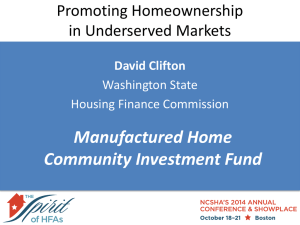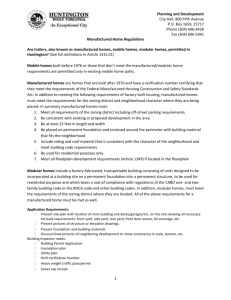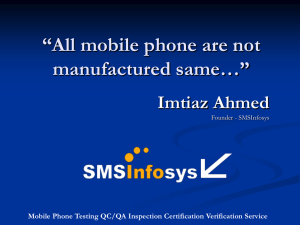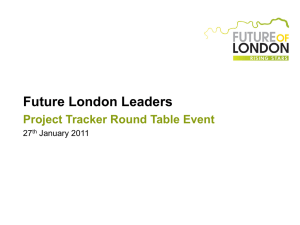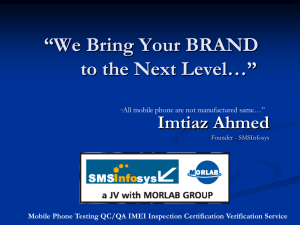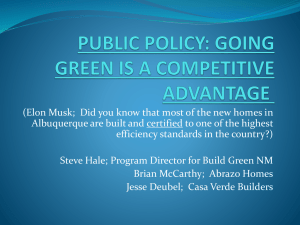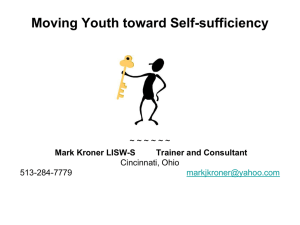Title Block
advertisement
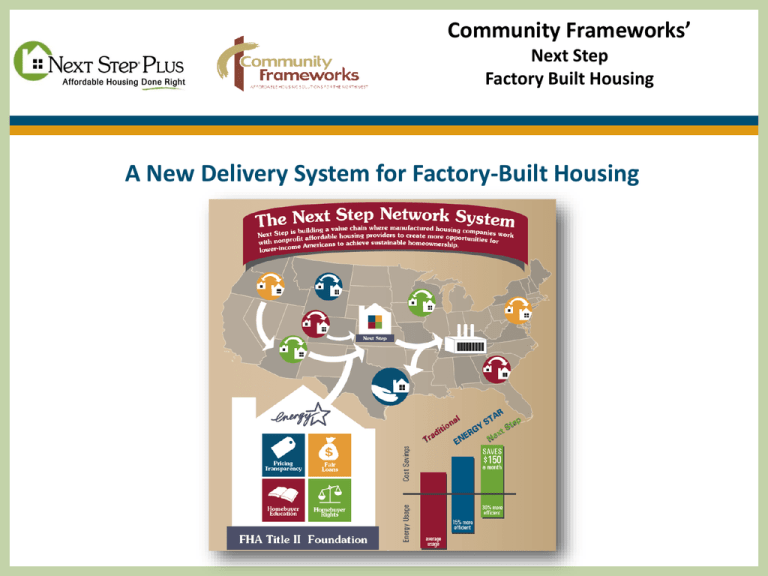
Community Frameworks’ Next Step Factory Built Housing A New Delivery System for Factory-Built Housing This Presentation An introduction: What is factory built housing? What are the advantages and challenges? What is the Next Step Network? How is Community Frameworks working with Next Step? How can you participate in the Next Step Plus Program? Factory Built Housing 101 Mobile Home A residential structure manufactured prior to the enactment of the Federal Manufactured Housing and Construction Standards, also known as the HUD Code, on June 15, 1976. Mobile homes are no longer being constructed. Manufactured Home Single family residential dwelling built in compliance with the Federal Manufactured Housing and Construction Standards, as amended, also known as the HUD Code, after June 15, 1976. Built in multi-sectional or single section units. Modular Home Homes built to the state Code where the home will be located. Sectional units are built in a production facility, transported to the site and assembled. Where is Manufactured Housing? Urban, Suburban and Rural Communities across the US What are the Advantages? While important in rural areas, manufactured housing (MH) also plays a critical role as a source of affordable housing in metropolitan areas. MH is not reliant on public subsidies. With policy and financing reform, MH has potential to be a scalable private sector model for delivery of affordable housing. With design and energy efficiency advances, MH today is indistinguishable from site-built homes and more energy efficient. MH can be constructed for less costs and in a climate controlled environment with less waste. As public funds are no longer assured, the need for a new solution has never been greater. The Challenges While Manufactured Housing (MH) is home to 17 million Americans, many challenges face this affordable housing solution. The market system which produces and finances these homes doesn’t always lead to the best wealth/asset building strategy. Nearly 2 million pre-1976 mobile homes (the year the HUD Code went into effect) still exist nationwide. Nonprofit developers need greater control, predictability of costs, and green choices to meet their affordable housing missions. What do Practitioners Need to Know? Manufactured Housing is the largest unsubsidized affordable housing stock in the US 8.6 M Manufactured Housing “homeowners” Serving families with an average income of $29,000 (around 50% of AMI) About 2.9 M own homes, but rent the land under them in 50,000 MH Communities High density, low impact development and efficient production Subsidized Housing 2.5 M LIHTC 2 M Section 8 Vouchers 1.2 M Public Housing Units Total: 5.7 M Who Lives in Manufactured Housing? Household Income, by Structure Type, 2009 $60,000 $50,000 $49,500 Median Income $40,000 $30,000 $30,000 $27,000 $20,000 $10,000 $0 Non Manufactured Homes Manufactured Homes Household Housing Structure HAC Tabulations of 2009 American Housing Survey Data Manufactured Homes in MHC Who Lives in Manufactured Housing? Housing Structure Type, Occupied Units, 2009 Mobile or manufactured home, 6.2% One unit detached, 63.2% 50 or more units, 4.5% 20 to 49 units, 3.3% 5 to 19 units, 9.0% 2 to 4 units, 8.0% One unit attached, 5.8% HAC Tabulations of 2005-2009 American Community Survey Estimates What are the Advantages? Despite the downturn in the housing industry, manufactured homes continue to be appealing to certain homebuyer demographics: Start-up families First-time buyers Low to moderate-income buyers Retirees looking for smaller, more affordable homes Workforce housing Factory built homes today are higher quality and offer more innovations than ever before. Affordable housing providers can match factory-built housing savings with innovative designs to create attractive, compact and affordable smart-growth communities in metro areas. What do Practitioners Need to Know? Manufactured Housing is home to about 17 million Americans. Manufactured Housing accounts for 43% of all homes under $150,000. 73% of manufactured home owners earn less than $50,000 a year. The market system that produces and finances these homes doesn’t always lead to the wealth building. Nearly 2 million pre-HUD Code mobile homes still exist nationwide. Next Step’s Theory of Change When a home is done right every single time, we can create an opportunity for systemic change. Next Step believes: A manufactured home designed to balance quality with affordability, built to ENERGY STAR standards and placed on an FHA Title II Permanent Foundation is central to the appreciation of factory-built housing values. Access to fair, fixed-rate home financing is essential to healthy housing markets and the capacity to build wealth through homeownership. Replacing pre-HUD Code mobile homes with ENERGY STAR homes can significantly drive down the cost of home ownership and reduce energy use. The Next Step System The Next Step System This System for doing business includes: 1. Homebuyers who are prepared and supported through certified homebuyer education programs; 2. Quality, ENERGY STAR homes on FHA Title II permanent foundations; 3. Sustainable financing: mortgages with fair terms that enable families to earn wealth or preserve assets; and, 4. “A Home is a Home” policy commitment advocating that owners of manufactured homes have the same rights as owners of sitebuilt homes. Network Members Financing for the Family Sustainable Financing: Mortgages with fair terms that enable families to earn wealth or preserve assets. How do you make financing work for the homebuyer? Rural Development 502 Direct Mortgage & 502 Guarantee. Local banks. Subsidies: • USDA Housing Preservation Grant • HOME • State Trust Fund • Federal Home Loan Bank • NeighborWorks® America • CFED I’M Home • Institutional Donors; Service clubs, faith-based organizations. • Rural Housing and Economic Development Grants How Financing Affects the Development Process What is an FHA Title II Foundation? A type of HUD FHA insured loan for manufactured housing—Real Estate Mortgage for homes on permanent foundations approved to FHA standards and by a structural engineer. Meets highest quality standard for permanent foundation and all lender requirements. Must meet all standards and be on a permanent foundation in compliance with the Permanent Foundation Guide for Manufactured Housing. A licensed professional engineer's seal and signature are required to indicate compliance with the Foundation Guide. The lender should furnish the appraiser with a design engineer's inspection of the foundation prior to the appraisal. Next Step’s Mission Our mission is putting sustainable homeownership within reach of everyone, while transforming the manufactured housing industry one home at a time. Community Frameworks’ Next Step Factory Built Housing A New Delivery System for Factory-Built Housing Tools of the Trade Factory Built Housing: A Vital “Tool” for Fulfilling our Missions as They Relate to Providing Quality, Affordable Housing to Low Income Individuals and Families Why You Should Care! Affordable Housing - Challenges: Increasing Governmental Regulations Increasing Production Costs Increasing Land Costs Increasing Demand Decreasing Funding Decreasing Quality/Quantity of Trades People Factory Built – Systems Built – Prefab Manufactured Modular HUD Code IRC – State Amendments Cost < Site Built Cost = Site Built Minimal Design Flexibility Maximum Design Flexibility Energy Efficient with Energy More Energy Efficient Star Appraisal < Site Built *Limited Financing Options Appraisal = Site Built Traditional Lending Sources Production Partners Manufacturing Facilities in the Northwest: HUD Code Manufactured Homes (also do modular): 5 – Oregon 4 – Idaho 1 – WA Modular Homes: 2 – ID 1 – OR Boutiques (Low Volume – Direct to Consumer) 3 – WA 1 - OR What are the Advantages? Benefits: Shorter Build Time Environmentally Sensitive Exempt from “Prevailing Wages” Superior Interior Sound Abatement Less Site Disruption/Neighbor Annoyance Higher Quality Construction Ideal for Tight/Urban and Remote Sites Mitigated Risks of Weather Damage Inherently More Green Stronger Structure Pacific Northwest Leaders Northwest Examples: NeighborWorks Umpqua and NeighborWorks Montana OPAL Community Land Trust Olympic Community Action Programs Kodiak Island Housing Authority WA State Migrant Council Salish and Kootenai Housing Authority Nez Perce Tribe Whitman County Community Action Center Native American Youth Family Center What are My Options? Factory Built Applications Replacement of Old “Trailers” Alternative to Traditional Site Built Urban Infill Multi-Family Development/Snr. Housing/Mixed Use Infill at ROC’s/NP Owned Parks Park Development Elder Cottages MH Example 1 MH Example 2 MH Example 3 Modular Example 1 Modular Example 2 Modular Example 3 Modular Example 4 Modular Example 5 Modular Example 6 Mobile Home Replacement: The Problem Mobile Home Replacement Efforts The Stringer Family approached NeighborWorks® Montana for assistance to weatherize their pre-HUD Code mobile home. Since the home was beyond repair, NeighborWorks Montana helped Ms. Stringer finance a new, ENERGY STAR certified manufactured home. Before After MH Interior Mod Set 1 Mod Set 2 Mod Set 3 Mod Set 4 Mod Set 5 What are the Advantages? Extreme Homebuilding with CRHDC The holiday season, record lows and 2 feet of snow and frost didn’t slow down Community Resources and Housing Development Corporation in Colorado from setting 11 modular homes. Just one example of how the factory-built construction process won’t come to a stand-still when weather, however extreme, hits. Bremerton Mod Bremerton Mod Bremerton Mod Bremerton Mod Bremerton Mod Bremerton Mod Bremerton Mod Bremerton Mod Hinged Roof Plant 1 Plant 2 Plant 3 Plant 4 Plant 5 Plant 6 Plant 7 Plant 8 Plant 9 Plant 10 Plant 11 SFR / Townhomes Multi-Family Senior Housing OlyCAP Senior Housing MF Set 1 MF Set 2 MF Set 3 MF Set 4 MF Set 5 MF Set 6 MF Set 7 ROC USA® – Infill Efforts NeighborWorks® Montana is providing new homes in ROC USA® Communities, where the residents collectively own the land (cooperative) and individually own their homes. Elder Cottage 1 Elder Cottage 2 Elder Cottage 3 Elder Cottage 4 Contact Information Thank you for your interest and participation! For further information, contact: Mark Wilson Community Frameworks 509.484.6733 x108

